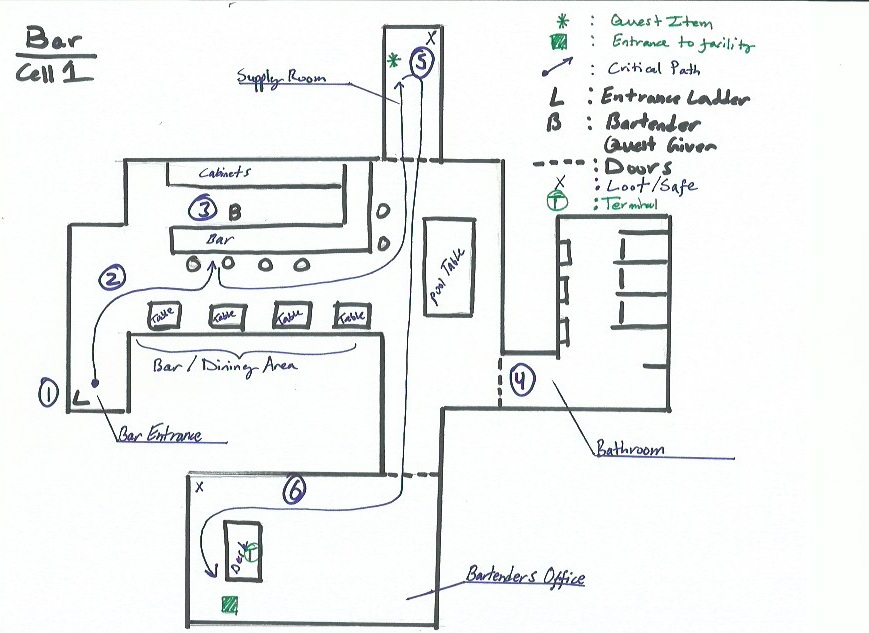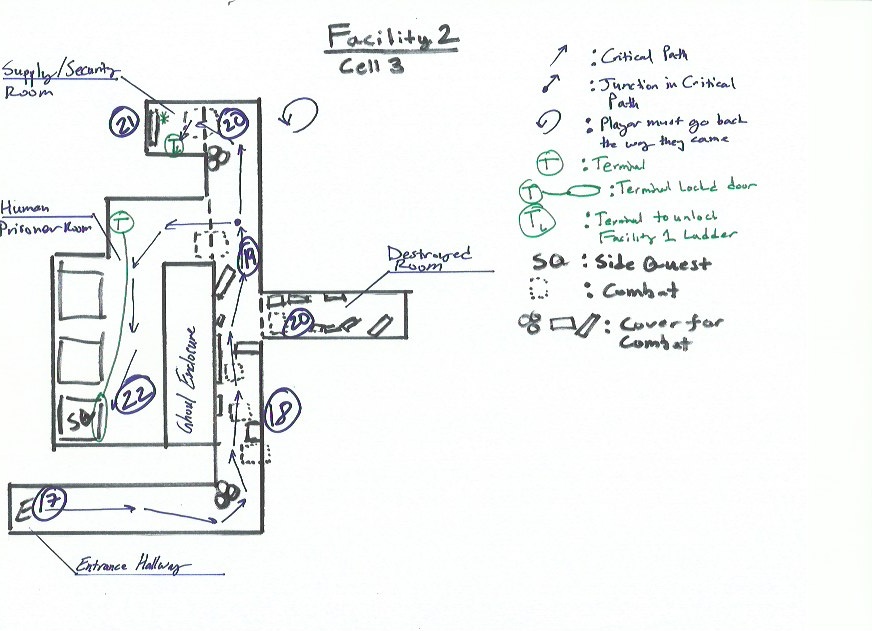What Happens in the Bar, Stays in the Bar
A Fallout 4 mod with multiple outcomes, difficult combat, and a mysterious backstory
Quick Summary
Development Facts
Engine: Creation Kit
Responsibilities: Design, blockout, gameplay design and implementation, aesthetic implementation, lighting, quest design, dialogue writer, and papyrus script writer.
Development Time: 105 hours
Game Mode: First/third person shooter
Design Goals
Develop character personality and backstory through dialogue and environmental storytelling (EX: Terminals)
Staged, scripted trigger controlled combat to create interesting gameplay experiences
Use staged combat and lighting to convey extra rooms in the facility
Provide a branching questline that allows for meaningful choices
Loot that rewards exploration, both in the form of items and lore
My Design Process Overview
Develop an outline of the quest structure, both main and sidequest.
Concept paper maps with projected encounter areas to visualize intended player experience.
Develop Whitebox and test gameplay for combat spaces, and quest dialogue.
Implement aesthetic clutter and lighting.











My Design Process
Quest Structure
Before creating the three level concepts, I began by designing the quest structure. The reason for starting with the quest structure was because it allowed me to get a sense of the intended player experience and length of gameplay: NPC conversations, objectives, branching dialogue/branching quest, and quest states. For this MOD, I crafted a player experience centered around a main quest that required three key items for completion, 1 main NPC, and a win/fail state. The second quest I developed was for a branching quest that happens when the player stumbles upon a second NPC during their search for the three key items. With this initial structure, I was able to start sketching and detailing each of the levels.
Paper Map for 3 Interior Cells
I designed each of the three interior cells with combat in mind. In terms of gameplay, I wanted the player to progress through combat in the following structure:
COMBAT->KEYCARD->UNLOCK AREA->COMBAT->KEYCARD/ITEM->COMBAT
The primary form of combat took place as staged combat encounters. This meant that enemies were placed with limited navmesh near objects of cover. The purpose of this was to allow the player to see the incoming enemies and focus on each enemy while going in and out behind cover. Along with this, encounters were scripted so that enemies would walk out behind locked doors, engaging the player in combat and unlocking the door behind them for the player to explore after the encounter.
The secondary form of combat was developed in the form of quick reflex combat. This was implemented halfway through the entire combat section to vary the pace. The enemies here were Ghouls, which do not shoot the player, rather they rush and melee the player. Along with this switch in combat dynamic, the Ghouls were scripted to spawn based on carefully place triggers around the Ghoul Containment Room (Map Marker 15 in Facility 1 Cell 2). The trigger based spawn system, coupled with the narrow sharp turn angles of the Ghoul Containment Room, created a combat situation where the player would have to react quickly to a ghoul popping out around the corner.
Conveying the Side Quest
One of the aspects I struggled with early on was creating proper environmental conveyance that lead to the branching sidequest NPC. The way this was achieved was in the form of a scripted combat encounter. Initially, the door is locked and inaccessible to the player, however, when the player approaches that area of the hallway, an enemy spawns behind the door and walks through the door. This unlocks the door behind them and engages the player in combat. This not only draws the players attention to explore the newly unlocked area (since exploration is a key part of a fallout experience), but also creates a reward for completing combat and exploring.
See Facility 2 Cell 3 Map Sketch Above
Environmental Storytelling
Part of the design was to convey a mysterious tale of a bar that exists in the “honeypot” settlement of the Covenant. The bartender is secretly creating a ghoul species that he can train. In order to do this, he is capturing wanderers that stumble upon his bar and the Covenant and promising them a special drink if they go to get the ingredients. Wanderers that accept his offer go down to end up being tricked and locked in an abandoned science facility with some prewar equipment.
In developing this narrative through environmental objects, I designed the 2 Facility cells to contain a broken hospital feel. Along with this, terminals were placed with notes from the bartender describing his experience with previous captives and his ghoul experiments. I included areas where rooms were filled with ghouls, however locked behind rusted cages. The player gets to walk in these areas and come into close proximity with a plethora of dangerous ghoul enemies, but doesn’t fight them or get harmed.
To see lighting and aesthetic clutter, please see screenshots above.





